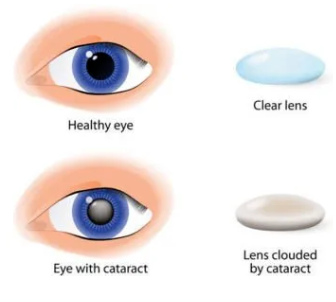Cataracts
What are Cataracts?
Cataracts are the appearance of a cloudy veil over a patient’s eyes and are one of the most common eye conditions.
As patients mature, the eye’s clear lens can begin to become cloudy and harden. As the lens becomes increasingly cloudy the vision out of the affected eye is reduced.
Patients often complain of a "film" across their vision, or "cloudy vision". Others refer to "blurry vision" or "increased glare".

What Causes Cataracts?
Any structural change in the lens proteins can alter its clarity and negatively impact vision.
The eye’s lens is located behind the iris (the coloured portion of the eye), and it is mostly made up of water and proteins. These specific proteins provide the lens with a transparent structure.
When a cataract occurs, the lens becomes cloudy and is seen as white patches in the centre of the pupil.
With time, the lens becomes more cloudy and is viewable as a white cloudy ball in the centre of the iris.
What Are the Symptoms of Cataracts?
Symptoms commonly associated with Cataracts include:
- Blurry or cloudy vision
- Faded colours
- Increased or extreme glare from lights
- Poor vision at night
- Difficulty with either near vision or distance vision
- Multiple images
- and Frequent changes in eye spectacle prescription
Who is at Risk of Cataracts?
Often, patients are in their 70’s or 80’s when Cataracts become a problem. The development of a cataract can occur as:
- A part of the natural ageing process
- An inherited syndrome
- A complication of other diseases such as glaucoma and diabetes
Patients are also at increased risk of cataract formation as a result of
- infections during pregnancy that can affect an infant’s eyes
- prolonged use of corticosteroid inhalers or eye drops
- excessive exposure to UV rays (sunlight)
- exposure to X-rays and other radiation during radiotherapy
Younger patients, who may have had an injury to the eye, can also be affected at a much earlier age.
What are the Stages of Cataracts?
Initially, only a small part of the eye lens is affected, and you will not notice any vision loss.
Over time, the cataract can grow more extensive, with your vision becoming increasingly cloudy.
Cataracts can cause patients to experience double vision or severe glare at an advanced stage.
Types of Cataracts
Cataracts may be classified based on their location within the eye, which include:
- Nuclear Cataract - Cloudiness is present in the centre of the lens
- Cortical Cataract - Cloudiness is seen as white spokes in the outer periphery of the lens
- Posterior Subcapsular Cataract - This occurs at the back of the lens capsule, which is like a shell of the lens. It may develop quicker than the other types of Cataracts and it is more commonly seen in patients with diabetes or on long-term steroid treatment
Diagnosis of Cataracts
To assess the impact of the cataract on your vision, your ophthalmologist will perform the following tests:
- Visual Acuity Test - This test involves reading an eye chart from a certain distance with one eye at a time.
- Eye Examination - A comprehensive eye examination will then be performed to assess the severity of the cataract.
- Slit Lamp Examination - A slit-lamp examination uses a microscope to examine the structures in front of the eye such as the lens and cornea, which are illuminated by a bright line of light.
- Retinal Examination - A retinal examination may be performed to look for problems with the retina. This involves the light-sensitive layer at the back of your eyes.
Treatment of Cataracts
Surgery is the only treatment option for Cataracts and is highly effective. Cataract Surgery is recommended when the cataract is severe enough to impact the patient's daily activities e.g. reading, and driving. Our ophthalmologists, use the latest technology to safely remove the Cataract under local anaesthesia.
Cataract Surgery involves the removal of the cloudy lens inside your eye and replacement with an artificial clear one, called an Intraocular Lens (IOL). Selection of the appropriate artificial IOL is done following a scan called an A-Scan that takes measurements of the eyeball. Cataracts do not heal on their own or with conservative treatment. Vision loss will only get worse and will lead to blindness if not treated by surgery.
What happens during Cataract Surgery?
Cataract surgery is a day procedure, and patients can return home that day.
An anaesthetist or nurse will place dilating and anaesthetic drops in the eye, followed by local anaesthetic to completely numb the eye. A sedative to help you relax may also be given.
The surgeon will then make a small incision in the side of the eye to remove the cloudy cataract and replace it with an intraocular lens.
The eye will then be padded overnight, and you will be reviewed the next day.







